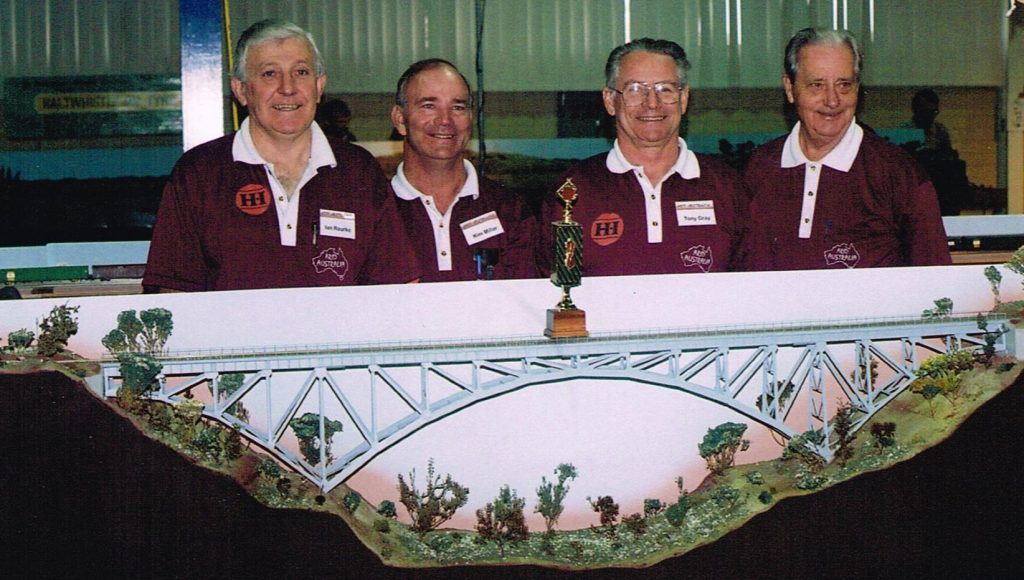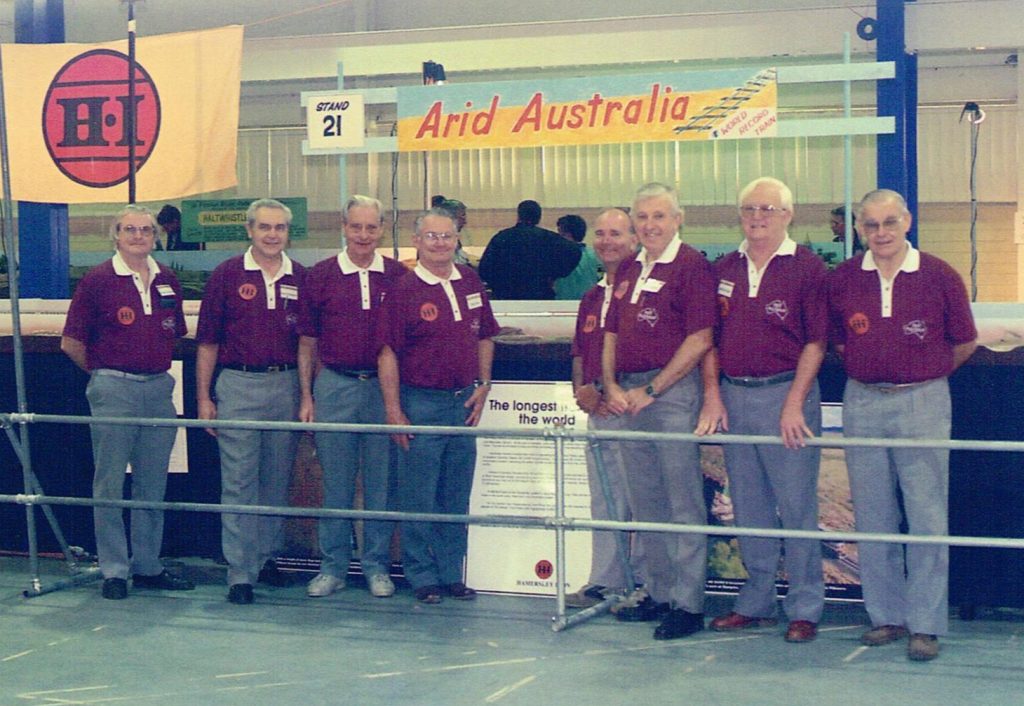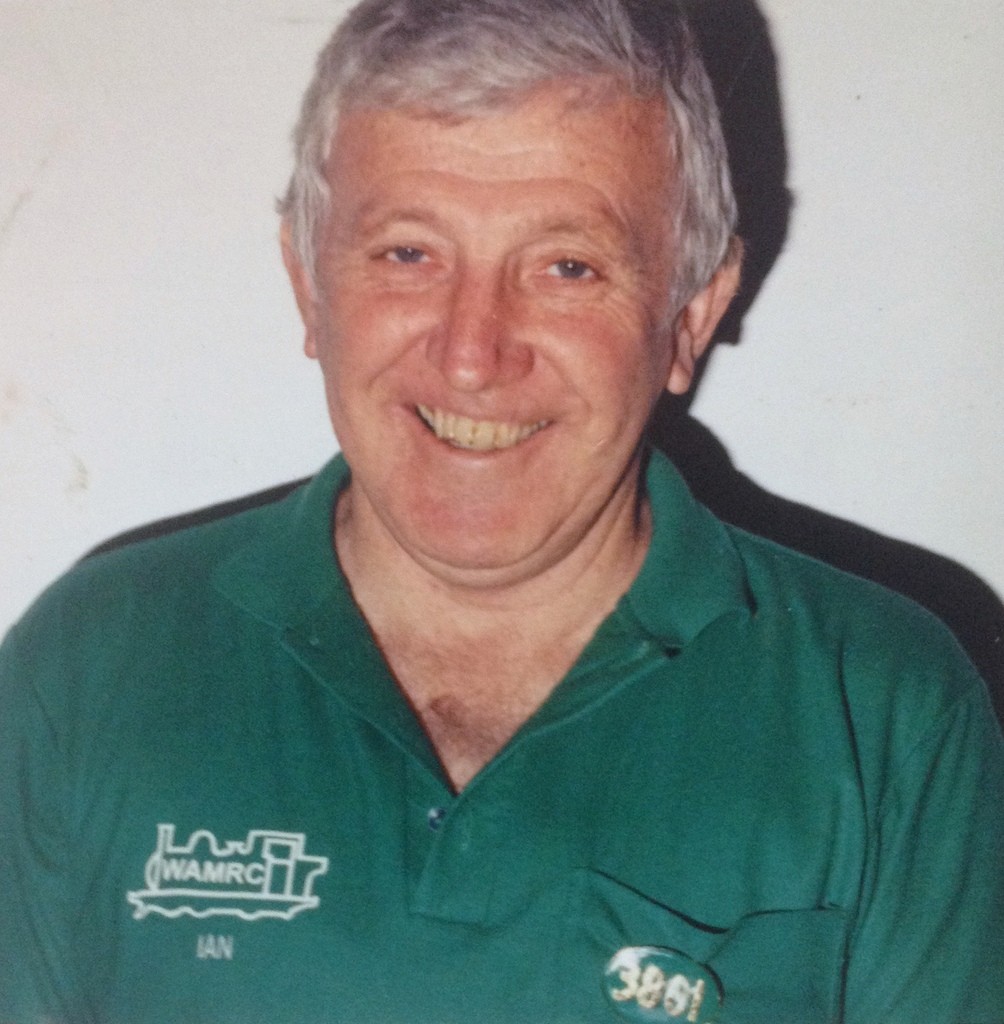R.I.P.
Ian Granville Rourke MBE(M)
2nd Dec 1939 — 19th Dec 2015
Member of the W.A.M.R.C. since 1987.
One of life’s true gentlemen — you will be missed!
At Ian’s funeral on 30/12/2015 the following eulogy was read by fellow WAMRC member Norm Chapple. It is reproduced here with the permission of Ian’s family and Norm.
Like Ian, I am a train tragic, and we shared an admiration for the dieselised, standard gauge Western Australian railways and the Commonwealth Railways and a desire to model with them, and for Ian the New South Wales Railways also.
I first met Ian in Collie in the early 1990s at Tubby Whiteside’s place. Ian and a couple of other West Australian Model Railway Club members had come down for a “training session”. I marvelled at this self-contained man in the VW combi van, though I did not envy him sleeping in it overnight, in winter. I also marvelled at what he produced from umpteen large foam boxes- beautifully painted and decalled locomotives, carriages and wagons- some bought, some converted from something else and some scratch built. Right there and then I was inspired to follow his example.
Over the next year or two, there were a couple of meetings at exhibitions and a couple of visits with Tubby to Ian’s home layout.
Then came an invitation to join Ian and a few like-minded modellers to put on a display of modelling Australian railways. I don’t know about the audience but we had a ball. Again I was inspired to continue my modelling efforts.
In 1995 I came up to Perth to the annual model railway exhibition and there was a brown coloured layout staffed by men in brown tops, one of whom was Ian. This was the first iteration of “Arid Australia”, a model railway layout that sought to showcase the iron ore railways of the Pilbara and the line across the Nullarbor. It seems that these gents: Ian, Tony, Len and Kim had been inspired by the previous display and decided that Australian railways was what they wanted to model.
Ian’s planning and engineering skills were a vital part of this, as was the case for the next nearly 20 years of layouts. I was invited to join them for the next year’s exhibition though I suspect ulterior motives at play here. They were all retired and I was still working and I think that they just wanted to keep an eye on me to see that I kept paying taxes so they could keep playing trains! That year we set a world record for the most number of wagons pulled for 8 scale kilometres or more on a model railway.
So each year till I retired I made the pilgrimage to Perth for the model railway exhibition to help on the layout, only able to participate during school holidays but made to feel very welcome. It was during this time that I truly appreciated the technical knowledge and expertise in construction that went into this ever larger layout. Everything had to fit perfectly for it to run reliably as there were 40, then 45, then 50, and eventually 54 modules to connect together. If the first module wasn’t exactly in place we were in trouble so Ian had mathematical calculations to ensure we got it right the first time. Every time we wanted to enlarge or change the shape of the layout, Ian had cardboard shapes cut to scale to work out what would work and what wouldn’t and a rationale for how we should operate it.
Ian’s admiration for the Commonwealth Railways lead him to build a layout to show the building of the Trans line from 1912 to completion in 1917. He altered locomotives to match those used, scratch built the wagons used to carry the sleepers, rails, water tanks and bunk houses and even the two rail laying machines that actually worked. For this, as well as the locos and wagons, Ian kitbashed the original 1912 timber carriages and scratch built a complete train of Wegmann carriages- older people here might remember these scarlet coloured carriages of the Trans Australian when passengers had to change trains at Kalgoorlie.
In later years, Ian started to build the early trains of NSW from 1855 on- tiny 4 wheeled carriages and wagons and odd looking locos. When I say build I do mean build- locos that were soldered together from brass or white metal and railway stock from plastic sheet.
We often had a show and tell of our latest constructions over a cuppa and fruit cake of a Saturday morning- I would marvel at his work and he was always complimentary about mine. We would also discuss railway matters, modelling tips and anything else that took our fancy- I shall miss those fruit cake sessions.
Ian was also a stalwart of the Bassendean Railway Museum, a life member who gave hundreds of hours of labour and planning to ensure that it is one of Australia’s best. I have fond memories of last year, sitting under a diesel loco on stands trying to swap large metal collars so that the bogies could be put under it. If our first attempt did not work, Ian always had another plan-if that didn’t work, we’d call it a day and Ian would spend the week thinking up new approaches. Ultimately we succeeded — though it did take a few weeks!
I was privileged to spend time with Ian in the last two weeks he was with us- we’d run trains around his layout, sometimes his trains, sometimes, mine. We would test the hauling capability of various new locos, discuss anything and everything about modelling and railways and sometimes just enjoy companionable silence- all the time with a copious supply of sausage rolls and fruit cake from Dorothy. Behind every good man…………
In the first week I asked Ian how to deal with folding brass etchings, he showed me how and suggested I bring them the next week. So there we sat on Tuesday, me cutting them off the etch and Ian folding them into the required shape only a couple of mm square. Such was the man!
Sadly we say goodbye to Ian today. Thank you for being my friend, mentor and inspiration. As one Arid Australia member said recently, he was an honourable gentleman to which I add a great but humble man, skilled in so many ways, admired and respected by all who knew him.
May you rest in peace.
The following obituary was prepared by WAMRC life member Don Finlayson.
IAN GRANVILLE ROURKE (MBE)
Ian Rourke was born in Kalgoorlie on December 2 1939 and spent his early and teen days in Kalgoorlie. For a kid interested in rail transport, Kalgoorlie had the WAGR 3′ 6″ gauge trains, an extensive tram network and the “big” trains of the Commonwealth Railways. As well as his interest in trains, Ian also had an interest in planes and he made models of planes out of wood. Some of the model planes he kept through his adult life.
In 1956, Ian joined the Royal Australian Air Force (RAAF). He was following in his late father’s career path by joining the Air Force as his father had served in the RAAF in World War 2 and whilst serving in England with the RAF as a Flight Sgt. (Rear Gunner) was lost in action in Europe in 1943. Ian achieved the rank of Squadron Leader (Navigator) in the RAAF and his service career which included time both in Australia and overseas ended in 1974, due to hearing loss.
Ian met Dorothy in 1954 and they married in 1964. They had three children who were very proud of their dad and his achievements.
Some years after the RAAF, Ian looked to the North West and the Pilbara for work and in 1984 was employed as Training Officer with Robe River Iron Associates in their Railway operations based at Cape Lambert. Ian took his family with him and they lived in the “Company town” — Wickham.
His interest in railways as a hobby again became an important part of his social life. He became a very active member of the Pilbara Railways Historical Society, where he served as President of the Society. One of his personal major achievements at the PRHS was the restoration and subsequent return to mainline service of the ex USA Western Pacific Railroad F7 diesel locomotive No. 5450. 5450 was used on historical society passenger trains as a back up to steam locomotive “PENDENNIS CASTLE”. Work on 5450 included the complete rewiring of the electrical system done mainly by Ian. He was also involved in the negotiations to bring the ex Great Western Railway (UK) steam locomotive “PENDENNIS CASTLE” to Perth in 1989 for the historic meeting with the “FLYING SCOTSMAN” (UK) steam locomotive during its visit to Perth.
Whilst in the Pilbara, Ian started building models of Commonwealth Railways trains, New South Wales trains and those of the Pilbara. He and Les Whiteside (who was also a member of our Club) had regular model railway evenings at Ian’s home in Wickham. Les introduced me to Ian in June 1986, when I was visiting Wickham.
Returning to the metro area in 1992, Ian rejoined Dorothy who had returned to Perth earlier and they settled into their Innaloo home where Ian had already claimed a room for his model railway. A second adjoining room was subsequently claimed and there were some alterations to the garage for the hobby to expand as well.
Ian joined our Club in 1987 and he was also a member of the Australian Railway Historical Society — WA Division (now Rail Heritage WA). He was made a life member of Rail Heritage in 2005. Ian had put many hours into the restoration of ex Commonwealth Railways passenger carriages for the Federation train which toured extensively in 2001 — the year of the Centenary of Federation. He also was involved in work on various exhibits at the museum.
For some time, Ian had ideas of a large portable model railway which could run long trains such as those of the Nullarbor and the Pilbara. Fellow Club member Tony Gray had similar ideas and the pair had discussions and in 1994, they floated the idea among other modellers (mainly retired members of our Club) and the “ARID AUSTRALIA” group was formed. Ian had been collecting old iron bed frames as the angle iron from these could be cut and welded to the desired size for the individual baseboards (modules) and each had a folding leg fitted which doubled for the stacking (storage) of the modules one on top of each other. All Ian’s design. Regular working bees were held and ARID AUSTRALIA Mk.1 (a rectangular layout consisting of 16 of the bed frame modules) was prepared and successfully exhibited at the 1995 Perth AMRA model railway exhibition. We successfully ran long passenger, freight and iron ore trains (bi- directional) on ARID AUSTRALIA and all from an idea that Ian and Tony had for the running of long exhibition trains. During this period Ian continued to quietly work on models and rolling stock of his own to run on the layout.
After the success of the first AMRA exhibition, it was thought that perhaps ARID AUSTRALIA could go for a world record model train. Research showed that the Guinness Book of Records had it that the longest model train had been run in 1978 in the USA and was of 501 cars and 10 locomotives. The ARID AUSTRALIA group decided we would “have a go” at the 1996 Perth AMRA Exhibition and the train would consist of Hamersley Iron ore cars. Ian acquired further bed frames for the angle iron for the modules the the layout now consisted of 32 modules and gave us a mainline run of some 72.25 metres (approx. 237 feet). Over the three days of the exhibition the record was broken on day one (June 01 1996) with three locomotives and 502 ore cars. Then on June 02 1996 we ran four locomotives and 602 ore cars and then on the final day of the Exhibition (June 03 1996) we ran four locomotives and 650 ore cars. The record train was 69.51 metres long (228 feet), leaving just 2.74 metres (9 feet) between the leading locomotive and the rear of the train. This was a very proud moment for Ian and he wrote a very detailed article on the planning for the record which was published in the Australian Model Railway Magazine (December 1996, pages 42 — 45). The record has since been broken by a group in Germany who ran a train of 1,000 four wheeled wagons.

Ian Rourke (left) with Kim Miller, Tony Gray and Len Hughes, part of the Arid Australia group and the AMRA trophy awarded to the best layout at the exhibition on Monday June 03 1996, the morning after the second World record train had been run. A very proud moment for Ian and the team involved with the Arid Australia “project”.
Plans for ARID AUSTRALIA to become even larger saw the necessity for the baseboards to be constructed of a lighter material for transportation. Tony Gray came up with the idea of angle tin and foam for the baseboards making each module about one third of the weight of a one of the bed frame modules. In total by the end of its exhibition life (2014), ARID AUSTRALIA consisted of 56 modules. As well as being exhibited at the Perth AMRA Exhibition over a number of years, ARID AUSTRALIA was also exhibited at Albany, Karratha, the Perth Royal Show for Hamersley Iron in 1998, Adelaide 1999 AMRA Exhibition and at the Sydney AMRA Exhibition in 2008. There was some damage done in the transport of the layout and repair work had to be done upon arrival at Karratha, Adelaide and one of the large bridges was extensively damaged on the trip to Sydney. All the bridge supports on the longer of the two bridges had to be replaced and with just three days before the Sydney exhibition opened.
Illness kept Ian from participating at the last outing of ARID AUSTRALIA at the 2014 Perth AMRA exhibition. He had Dorothy bring him to the exhibition to see that it was all going well.
Ian was Awarded an MBE in 1972 for outstanding service in the RAAF.
In 2015, Ian was told that he had leukaemia. Both his brother and sister had died of leukaemia which wasn’t a good sign for Ian. His last five weeks were spent in hospital with a special treat on Tuesday mornings of being permitted to go home for “model train therapy”. Norm Chapple or Dorothy would pick him up, take him home where he and Norm spent time in his model railway room, running trains and reminiscing.
Ian Rourke died on December 19 2015 and Club members and those from the Arid Australia group were conspicuous among the mourners at his funeral on December 30 2015, wearing either the Club green polo shirt or the maroon Arid Australia polo shirt.

Most of the Arid Australia team at the 1996 AMRA Exhibition — Norm Chapple, (left), Don Finlayson, Len Hughes, Tony Gray, Kim Miller, Ian Rourke, Brian Few and Peter Scarfe. Not present in the photo — Henry Brooks and Peter Tullis. Photo taken on June 03 1996 — courtesy Don Finlayson.
This obituary was prepared by Club life member Don Finlayson.

